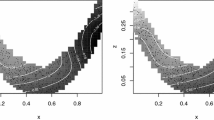Abstract
Pairwise preference data are represented as a monotone integral transformation of difference on the underlying stimulus-object or utility scale. The class of monotone transformations considered is that in which the kernel of the integral is a linear combination of B-splines. Two types of data are analyzed: binary and continuous. The parameters of the transformation and the underlying scale values or utilities are estimated by maximum likelihood with inequality constraints on the transformation parameters. Various hypothesis tests and interval estimates are developed. Examples of artificial and real data are presented.
Similar content being viewed by others
References Notes
de Boor, C. & Rice, J. R.Least squares cubic spline approximation. I-Fixed knots; II-Variable knots (CSD TR 20 and 21). West Lafayette, Indiana: Purdue University, 1968.
Lord, F.Estimating item characteristic curves without knowledge of their mathematical form (RB-68-8). Princeton, New Jersey: Educational Testing Service, 1968.
Steiger, J. H. & Lind, J. M.Statistically based tests for the number of common factors. Paper presented at the annual meeting of the Psychometric Society, Iowa City, 1980.
References
Akaike, H. A new look at the statistical model.IEEE Transactions on Automatic Control, 1974,19, 716–723.
Bechtel, G.Multidimensional preference scaling. The Hague: Mouton, 1976.
Bradley, R. A., & Terry, M. E. Rank analysis of incomplete block designs. 1. The method of paired comparisons.Biometrika, 1952,39, 324–345.
Chernoff, H. On the distribution of the likelihood ratio.The Annals of Mathematical Statistics, 1954,25, 573–578.
Cox, M. G. The numerical evaluation of B-splines.Journal of the Institute of Mathematics and its Applications, 1972,10, 134–149.
Curry, H. B. & Schoenberg, I. J. On spline distributions and their limits: The Polya distribution functions, Abstract 380t.Bulletin of the American Mathematical Society, 1947,53, 1114.
Curry, H. B. & Schoenberg, I. J. On Polya frequency functions. IV: The fundamental spline functions and their limits.Journal d.Analyse Mathématique, 1966,17, 71–107.
de Boor, C. On calculating with B-splines.Journal of Approximating Theory, 1972,6, 50–62.
de Boor, C.A practical guide to splines. New York: Springer Verlag, 1978.
Feder, P. I. On the distribution of the log-likelihood ratio test statistic when the true parameter is “near” the boundaries of the hypothesis regions.The Annals of Mathematical Statistics, 1968,39, 2044–2055.
Ford, L. R. Jr. Solution of a ranking problem from binary comparisons. Herbert Ellsworth Slaught Memorial Papers.American Mathematics Monthly, 1957,64, 28–33.
Guilford, J. P. Some empirical tests of the method of paired comparisons.Journal of General Psychology, 1931,5, 64–77.
Guilford, J. P. Psychometric methods (2 ed.). New York: McGraw-Hill, 1954.
Hohle, R. H. An empirical evaluation and comparison of two models for discriminability scales.Journal of Mathematical Psychology, 1966,3, 174–183.
Kruskal, J. B. Analysis of factorial experiments by estimating monotone transformation of the data.Journal of the Royal Statistical Society, Series B, 1965,27, 251–263.
de Leeuw, J., Young, F. W., & Takane, Y. Additive structures in qualitative data: An alternating least squares method with optimal scaling features.Psychometrika, 1976,41, 471–503.
Luce, R. D. Individual choice behavior. New York: Wiley, 1959.
Mosteller, F. The mystery of the missing corpus.Psychometrika, 1958,23, 279–289.
Ramsay, J. O. Monotonic weighted power transformations to additivity.Psychometrika, 1977,42, 83–109.
Ramsay, J. O. Confidence regions for multidimensional scaling analysis.Psychometrika, 1978,43, 145–160.
Schwarz, G. Estimating the dimension of a model.The Annals of Statistics, 1978,6, 461–464.
Takane, Y., Young, F. W. & de Leeuw, J. An individual differences additive model: An alternating least squares method with optimal scaling features.Psychometrika, 1980,45, 183–209.
Thurstone, L. L. A law of comparitive judgment.Psychological Review, 1927,34, 273–286.
Winsberg, S. & Ramsay, J. O. Monotonic Transformations to Additivity using splines.Biometrika, 1980,67, 669–674.
Author information
Authors and Affiliations
Additional information
This investigation was supported in part by a research grant from the Natural Sciences and Engineering Research Council Canada.
Rights and permissions
About this article
Cite this article
Winsberg, S., Ramsay, J.O. Analysis of pairwise preference data using integrated B-splines. Psychometrika 46, 171–186 (1981). https://doi.org/10.1007/BF02293898
Received:
Revised:
Issue Date:
DOI: https://doi.org/10.1007/BF02293898




